Hertfordshire Law: Critically Evaluating the Youth Justice Policy
VerifiedAdded on 2023/05/31
|6
|1565
|183
Essay
AI Summary
This essay critically examines the 'children first-offenders second' approach within the current youth justice system. It explores the principles of intervention, prevention, and diversion that underpin this policy, highlighting its progressive and reactionary aspects. The essay analyzes the model's emphasis on child-friendly interventions and partnerships between children and practitioners. It further discusses the role of the bureau model in providing genuine diversion from the youth justice system and promoting positive outcomes for young offenders. The essay concludes by emphasizing the importance of comprehending the lives of children within the justice system, aligning with the policy's aim to prioritize their well-being and development.
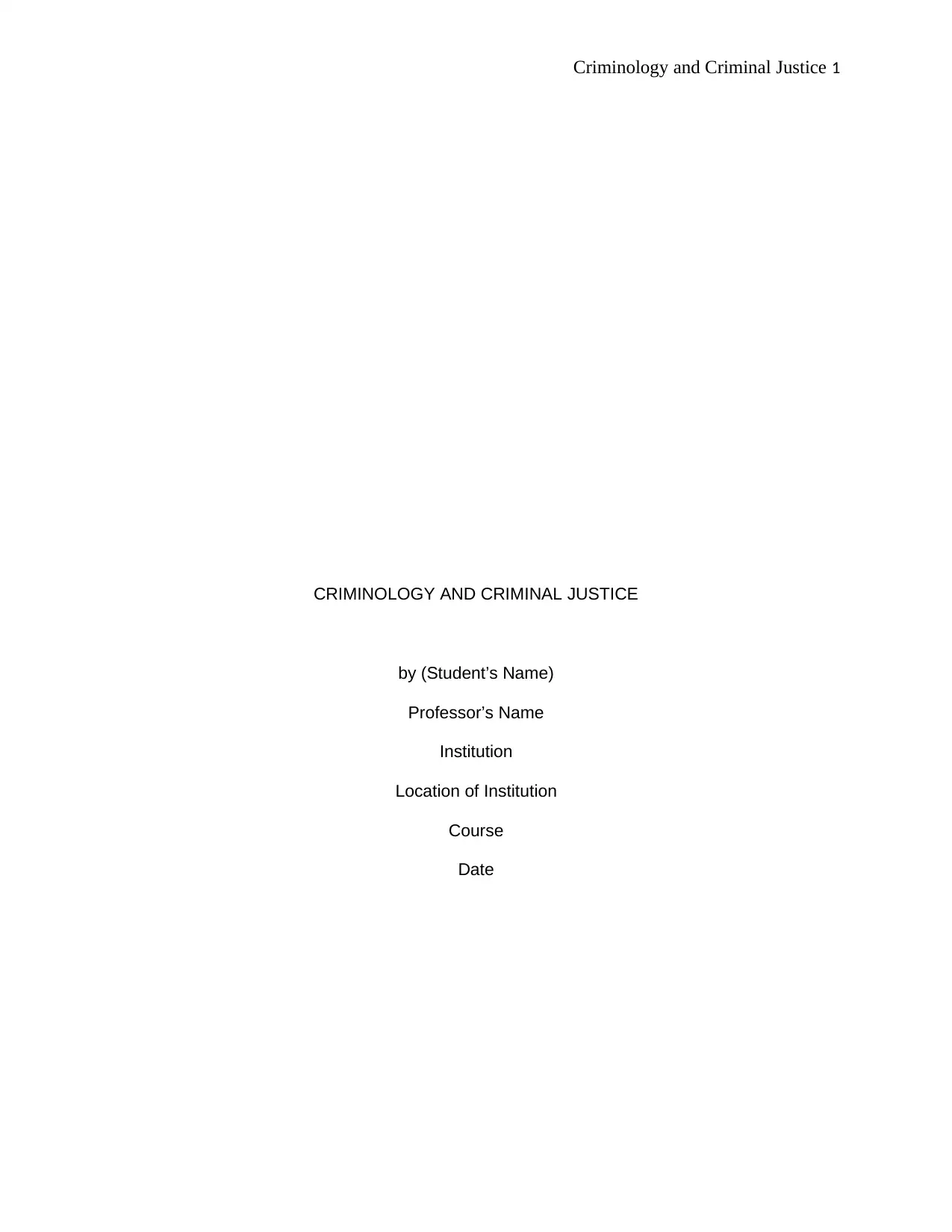
Criminology and Criminal Justice 1
CRIMINOLOGY AND CRIMINAL JUSTICE
by (Student’s Name)
Professor’s Name
Institution
Location of Institution
Course
Date
CRIMINOLOGY AND CRIMINAL JUSTICE
by (Student’s Name)
Professor’s Name
Institution
Location of Institution
Course
Date
Paraphrase This Document
Need a fresh take? Get an instant paraphrase of this document with our AI Paraphraser
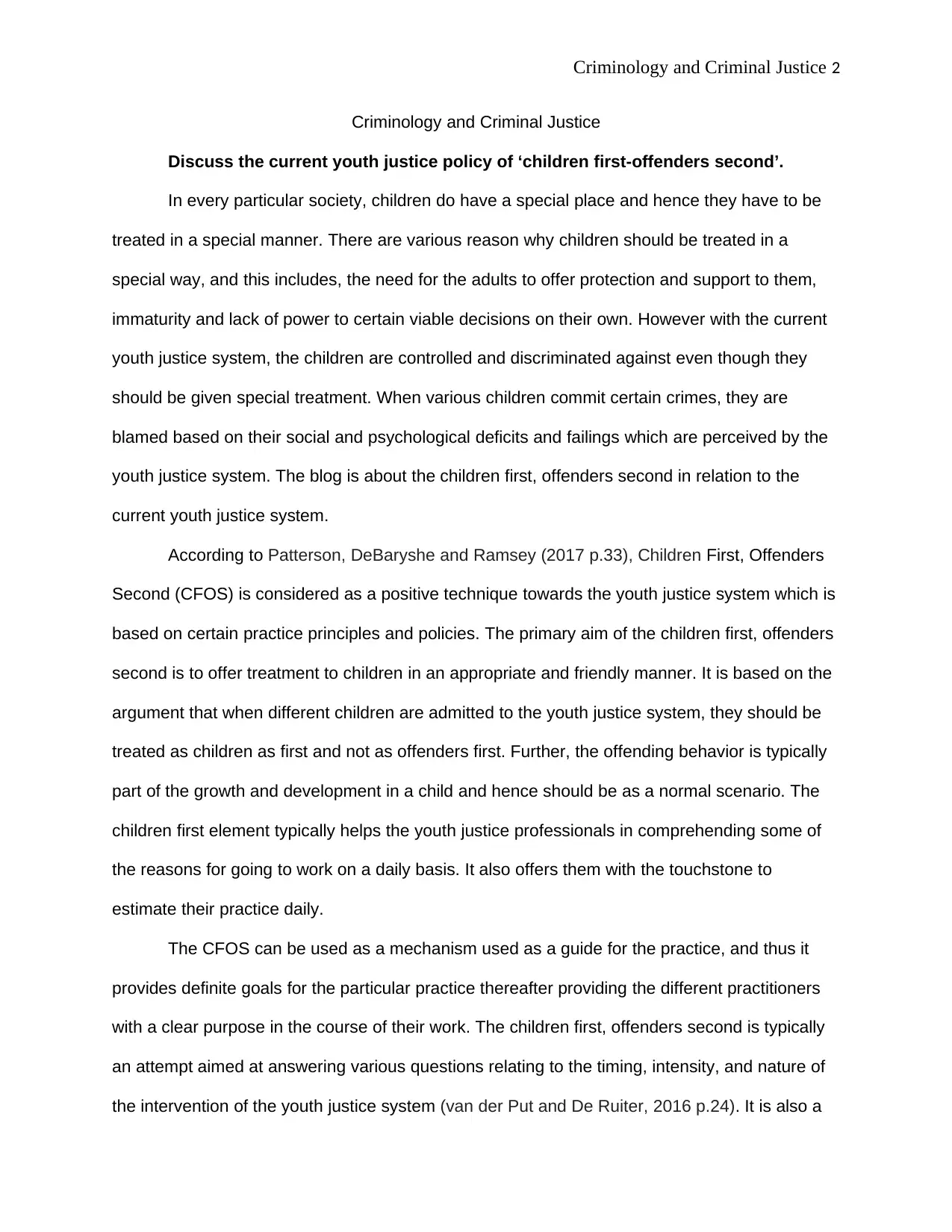
Criminology and Criminal Justice 2
Criminology and Criminal Justice
Discuss the current youth justice policy of ‘children first-offenders second’.
In every particular society, children do have a special place and hence they have to be
treated in a special manner. There are various reason why children should be treated in a
special way, and this includes, the need for the adults to offer protection and support to them,
immaturity and lack of power to certain viable decisions on their own. However with the current
youth justice system, the children are controlled and discriminated against even though they
should be given special treatment. When various children commit certain crimes, they are
blamed based on their social and psychological deficits and failings which are perceived by the
youth justice system. The blog is about the children first, offenders second in relation to the
current youth justice system.
According to Patterson, DeBaryshe and Ramsey (2017 p.33), Children First, Offenders
Second (CFOS) is considered as a positive technique towards the youth justice system which is
based on certain practice principles and policies. The primary aim of the children first, offenders
second is to offer treatment to children in an appropriate and friendly manner. It is based on the
argument that when different children are admitted to the youth justice system, they should be
treated as children as first and not as offenders first. Further, the offending behavior is typically
part of the growth and development in a child and hence should be as a normal scenario. The
children first element typically helps the youth justice professionals in comprehending some of
the reasons for going to work on a daily basis. It also offers them with the touchstone to
estimate their practice daily.
The CFOS can be used as a mechanism used as a guide for the practice, and thus it
provides definite goals for the particular practice thereafter providing the different practitioners
with a clear purpose in the course of their work. The children first, offenders second is typically
an attempt aimed at answering various questions relating to the timing, intensity, and nature of
the intervention of the youth justice system (van der Put and De Ruiter, 2016 p.24). It is also a
Criminology and Criminal Justice
Discuss the current youth justice policy of ‘children first-offenders second’.
In every particular society, children do have a special place and hence they have to be
treated in a special manner. There are various reason why children should be treated in a
special way, and this includes, the need for the adults to offer protection and support to them,
immaturity and lack of power to certain viable decisions on their own. However with the current
youth justice system, the children are controlled and discriminated against even though they
should be given special treatment. When various children commit certain crimes, they are
blamed based on their social and psychological deficits and failings which are perceived by the
youth justice system. The blog is about the children first, offenders second in relation to the
current youth justice system.
According to Patterson, DeBaryshe and Ramsey (2017 p.33), Children First, Offenders
Second (CFOS) is considered as a positive technique towards the youth justice system which is
based on certain practice principles and policies. The primary aim of the children first, offenders
second is to offer treatment to children in an appropriate and friendly manner. It is based on the
argument that when different children are admitted to the youth justice system, they should be
treated as children as first and not as offenders first. Further, the offending behavior is typically
part of the growth and development in a child and hence should be as a normal scenario. The
children first element typically helps the youth justice professionals in comprehending some of
the reasons for going to work on a daily basis. It also offers them with the touchstone to
estimate their practice daily.
The CFOS can be used as a mechanism used as a guide for the practice, and thus it
provides definite goals for the particular practice thereafter providing the different practitioners
with a clear purpose in the course of their work. The children first, offenders second is typically
an attempt aimed at answering various questions relating to the timing, intensity, and nature of
the intervention of the youth justice system (van der Put and De Ruiter, 2016 p.24). It is also a
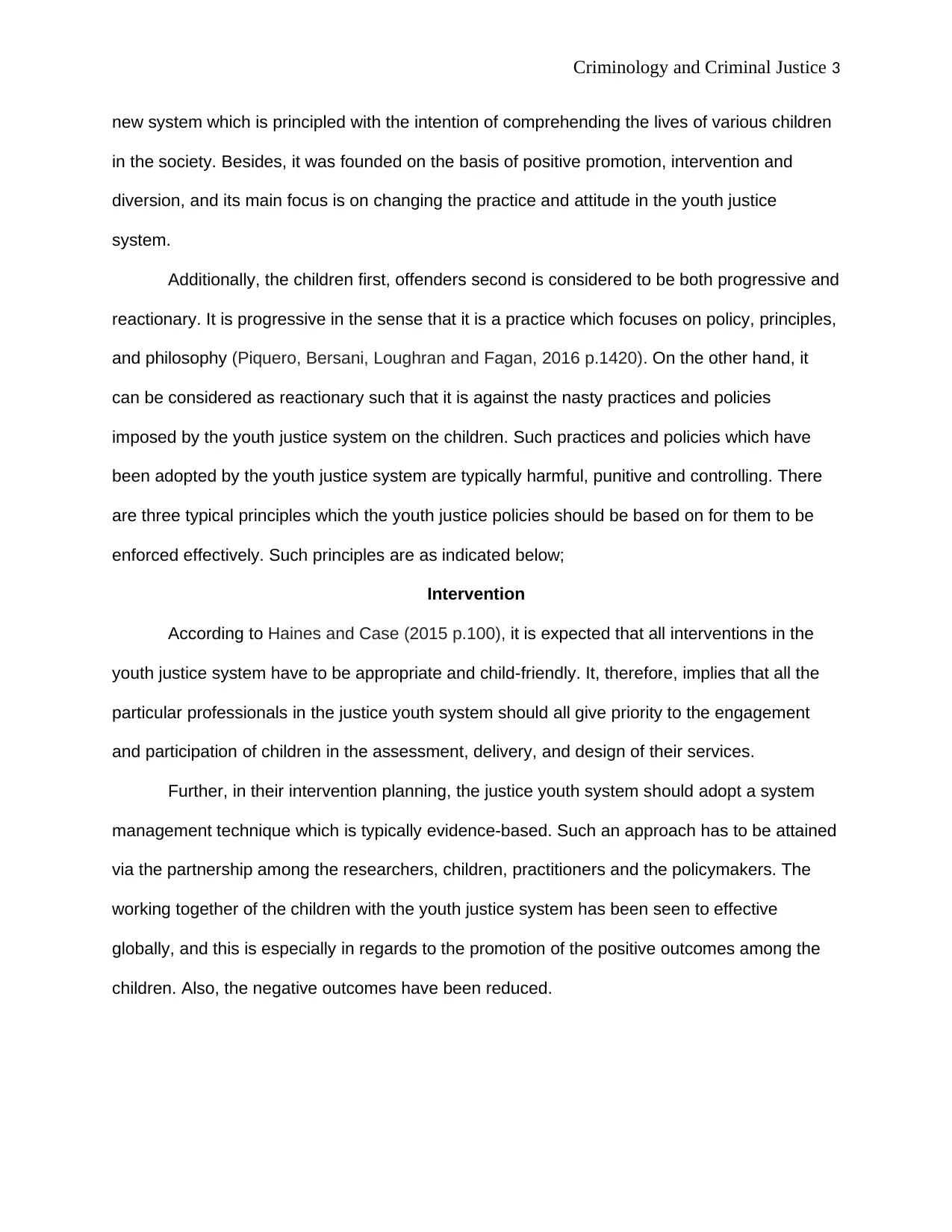
Criminology and Criminal Justice 3
new system which is principled with the intention of comprehending the lives of various children
in the society. Besides, it was founded on the basis of positive promotion, intervention and
diversion, and its main focus is on changing the practice and attitude in the youth justice
system.
Additionally, the children first, offenders second is considered to be both progressive and
reactionary. It is progressive in the sense that it is a practice which focuses on policy, principles,
and philosophy (Piquero, Bersani, Loughran and Fagan, 2016 p.1420). On the other hand, it
can be considered as reactionary such that it is against the nasty practices and policies
imposed by the youth justice system on the children. Such practices and policies which have
been adopted by the youth justice system are typically harmful, punitive and controlling. There
are three typical principles which the youth justice policies should be based on for them to be
enforced effectively. Such principles are as indicated below;
Intervention
According to Haines and Case (2015 p.100), it is expected that all interventions in the
youth justice system have to be appropriate and child-friendly. It, therefore, implies that all the
particular professionals in the justice youth system should all give priority to the engagement
and participation of children in the assessment, delivery, and design of their services.
Further, in their intervention planning, the justice youth system should adopt a system
management technique which is typically evidence-based. Such an approach has to be attained
via the partnership among the researchers, children, practitioners and the policymakers. The
working together of the children with the youth justice system has been seen to effective
globally, and this is especially in regards to the promotion of the positive outcomes among the
children. Also, the negative outcomes have been reduced.
new system which is principled with the intention of comprehending the lives of various children
in the society. Besides, it was founded on the basis of positive promotion, intervention and
diversion, and its main focus is on changing the practice and attitude in the youth justice
system.
Additionally, the children first, offenders second is considered to be both progressive and
reactionary. It is progressive in the sense that it is a practice which focuses on policy, principles,
and philosophy (Piquero, Bersani, Loughran and Fagan, 2016 p.1420). On the other hand, it
can be considered as reactionary such that it is against the nasty practices and policies
imposed by the youth justice system on the children. Such practices and policies which have
been adopted by the youth justice system are typically harmful, punitive and controlling. There
are three typical principles which the youth justice policies should be based on for them to be
enforced effectively. Such principles are as indicated below;
Intervention
According to Haines and Case (2015 p.100), it is expected that all interventions in the
youth justice system have to be appropriate and child-friendly. It, therefore, implies that all the
particular professionals in the justice youth system should all give priority to the engagement
and participation of children in the assessment, delivery, and design of their services.
Further, in their intervention planning, the justice youth system should adopt a system
management technique which is typically evidence-based. Such an approach has to be attained
via the partnership among the researchers, children, practitioners and the policymakers. The
working together of the children with the youth justice system has been seen to effective
globally, and this is especially in regards to the promotion of the positive outcomes among the
children. Also, the negative outcomes have been reduced.
⊘ This is a preview!⊘
Do you want full access?
Subscribe today to unlock all pages.

Trusted by 1+ million students worldwide
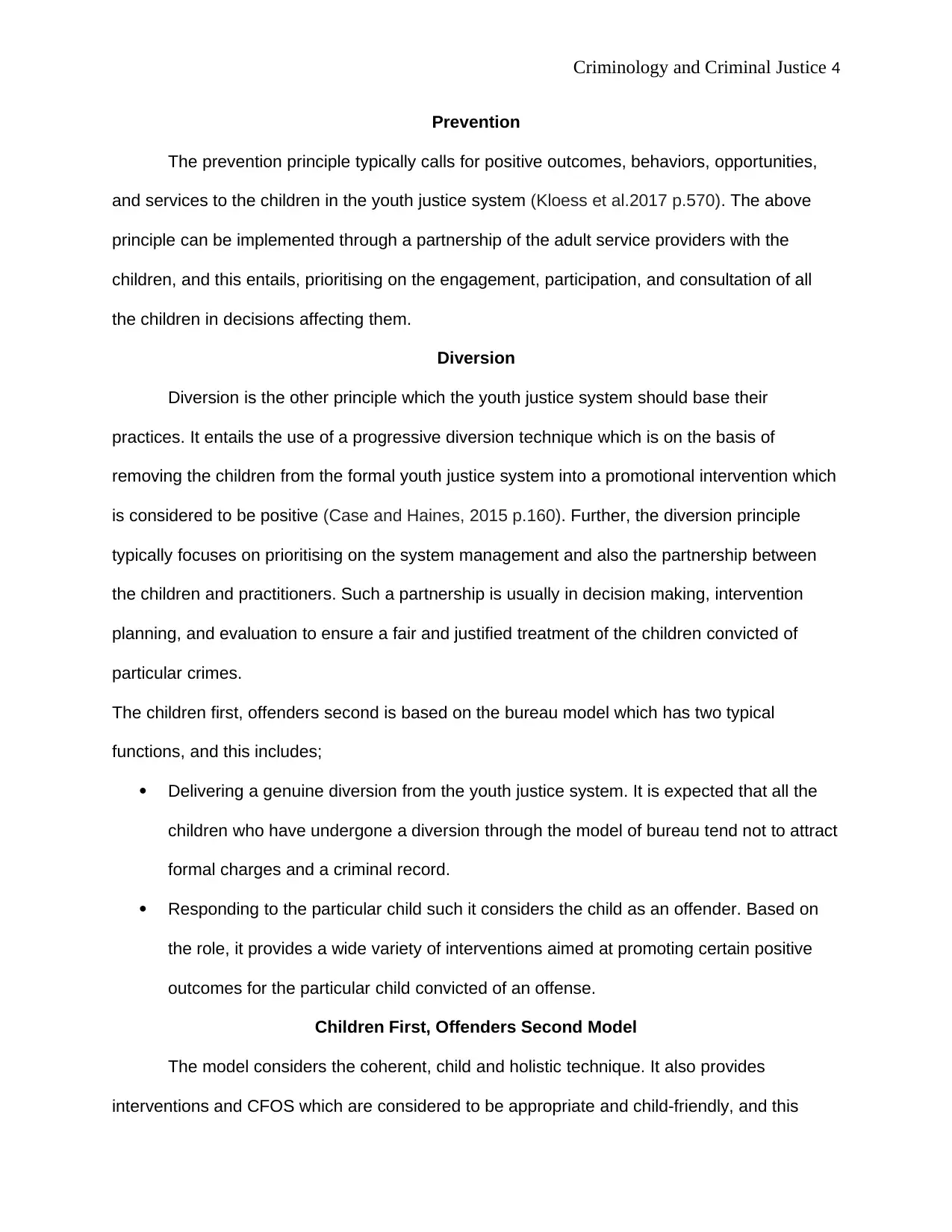
Criminology and Criminal Justice 4
Prevention
The prevention principle typically calls for positive outcomes, behaviors, opportunities,
and services to the children in the youth justice system (Kloess et al.2017 p.570). The above
principle can be implemented through a partnership of the adult service providers with the
children, and this entails, prioritising on the engagement, participation, and consultation of all
the children in decisions affecting them.
Diversion
Diversion is the other principle which the youth justice system should base their
practices. It entails the use of a progressive diversion technique which is on the basis of
removing the children from the formal youth justice system into a promotional intervention which
is considered to be positive (Case and Haines, 2015 p.160). Further, the diversion principle
typically focuses on prioritising on the system management and also the partnership between
the children and practitioners. Such a partnership is usually in decision making, intervention
planning, and evaluation to ensure a fair and justified treatment of the children convicted of
particular crimes.
The children first, offenders second is based on the bureau model which has two typical
functions, and this includes;
Delivering a genuine diversion from the youth justice system. It is expected that all the
children who have undergone a diversion through the model of bureau tend not to attract
formal charges and a criminal record.
Responding to the particular child such it considers the child as an offender. Based on
the role, it provides a wide variety of interventions aimed at promoting certain positive
outcomes for the particular child convicted of an offense.
Children First, Offenders Second Model
The model considers the coherent, child and holistic technique. It also provides
interventions and CFOS which are considered to be appropriate and child-friendly, and this
Prevention
The prevention principle typically calls for positive outcomes, behaviors, opportunities,
and services to the children in the youth justice system (Kloess et al.2017 p.570). The above
principle can be implemented through a partnership of the adult service providers with the
children, and this entails, prioritising on the engagement, participation, and consultation of all
the children in decisions affecting them.
Diversion
Diversion is the other principle which the youth justice system should base their
practices. It entails the use of a progressive diversion technique which is on the basis of
removing the children from the formal youth justice system into a promotional intervention which
is considered to be positive (Case and Haines, 2015 p.160). Further, the diversion principle
typically focuses on prioritising on the system management and also the partnership between
the children and practitioners. Such a partnership is usually in decision making, intervention
planning, and evaluation to ensure a fair and justified treatment of the children convicted of
particular crimes.
The children first, offenders second is based on the bureau model which has two typical
functions, and this includes;
Delivering a genuine diversion from the youth justice system. It is expected that all the
children who have undergone a diversion through the model of bureau tend not to attract
formal charges and a criminal record.
Responding to the particular child such it considers the child as an offender. Based on
the role, it provides a wide variety of interventions aimed at promoting certain positive
outcomes for the particular child convicted of an offense.
Children First, Offenders Second Model
The model considers the coherent, child and holistic technique. It also provides
interventions and CFOS which are considered to be appropriate and child-friendly, and this
Paraphrase This Document
Need a fresh take? Get an instant paraphrase of this document with our AI Paraphraser
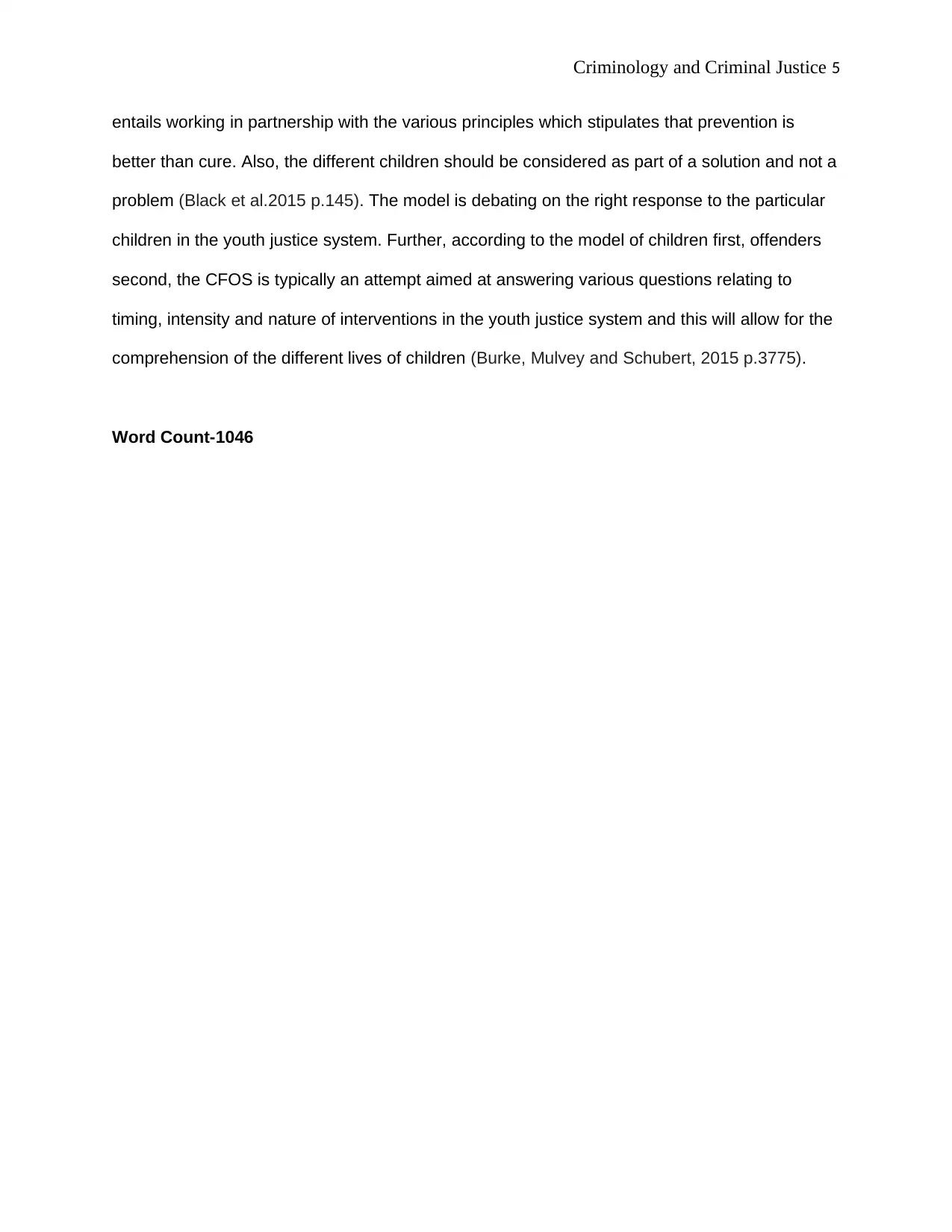
Criminology and Criminal Justice 5
entails working in partnership with the various principles which stipulates that prevention is
better than cure. Also, the different children should be considered as part of a solution and not a
problem (Black et al.2015 p.145). The model is debating on the right response to the particular
children in the youth justice system. Further, according to the model of children first, offenders
second, the CFOS is typically an attempt aimed at answering various questions relating to
timing, intensity and nature of interventions in the youth justice system and this will allow for the
comprehension of the different lives of children (Burke, Mulvey and Schubert, 2015 p.3775).
Word Count-1046
entails working in partnership with the various principles which stipulates that prevention is
better than cure. Also, the different children should be considered as part of a solution and not a
problem (Black et al.2015 p.145). The model is debating on the right response to the particular
children in the youth justice system. Further, according to the model of children first, offenders
second, the CFOS is typically an attempt aimed at answering various questions relating to
timing, intensity and nature of interventions in the youth justice system and this will allow for the
comprehension of the different lives of children (Burke, Mulvey and Schubert, 2015 p.3775).
Word Count-1046
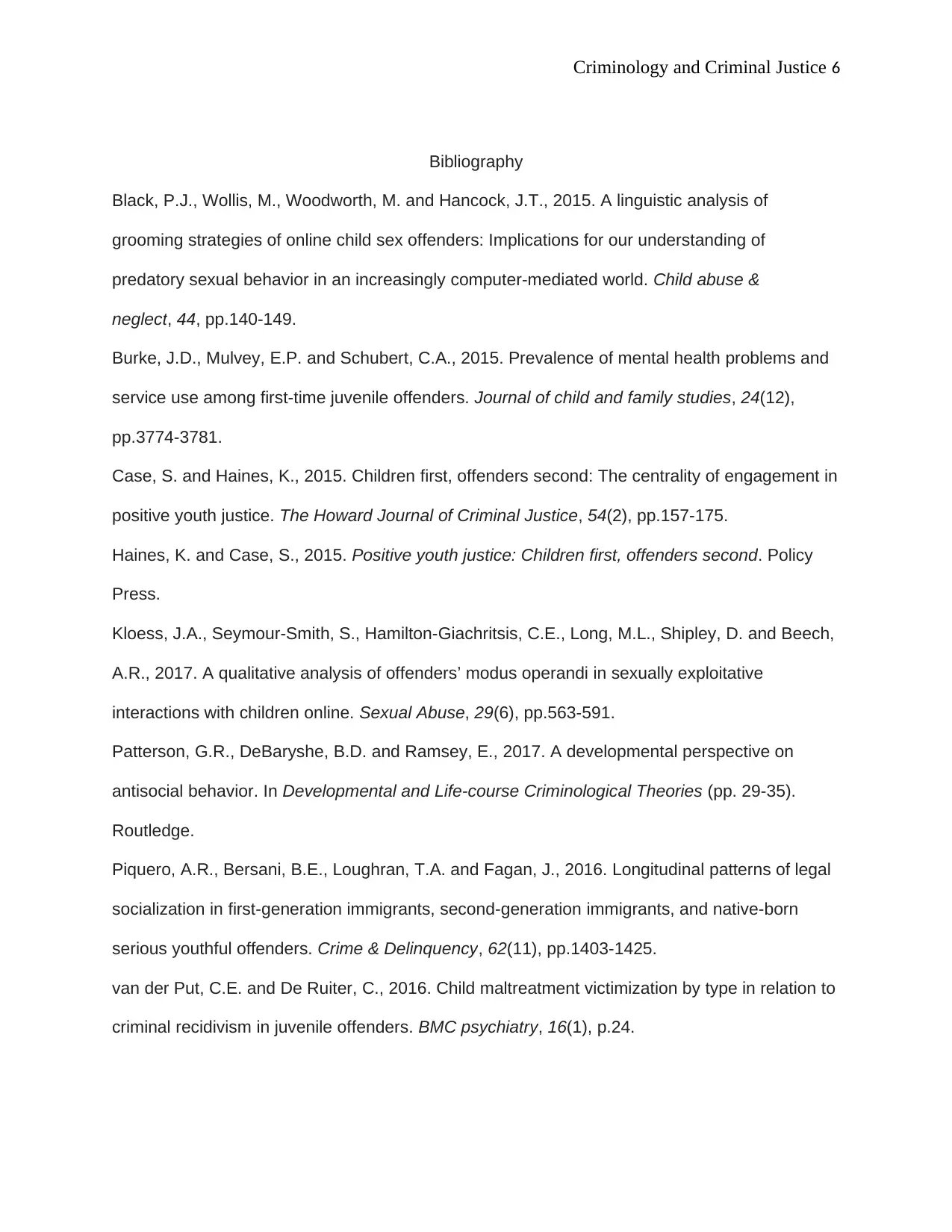
Criminology and Criminal Justice 6
Bibliography
Black, P.J., Wollis, M., Woodworth, M. and Hancock, J.T., 2015. A linguistic analysis of
grooming strategies of online child sex offenders: Implications for our understanding of
predatory sexual behavior in an increasingly computer-mediated world. Child abuse &
neglect, 44, pp.140-149.
Burke, J.D., Mulvey, E.P. and Schubert, C.A., 2015. Prevalence of mental health problems and
service use among first-time juvenile offenders. Journal of child and family studies, 24(12),
pp.3774-3781.
Case, S. and Haines, K., 2015. Children first, offenders second: The centrality of engagement in
positive youth justice. The Howard Journal of Criminal Justice, 54(2), pp.157-175.
Haines, K. and Case, S., 2015. Positive youth justice: Children first, offenders second. Policy
Press.
Kloess, J.A., Seymour-Smith, S., Hamilton-Giachritsis, C.E., Long, M.L., Shipley, D. and Beech,
A.R., 2017. A qualitative analysis of offenders’ modus operandi in sexually exploitative
interactions with children online. Sexual Abuse, 29(6), pp.563-591.
Patterson, G.R., DeBaryshe, B.D. and Ramsey, E., 2017. A developmental perspective on
antisocial behavior. In Developmental and Life-course Criminological Theories (pp. 29-35).
Routledge.
Piquero, A.R., Bersani, B.E., Loughran, T.A. and Fagan, J., 2016. Longitudinal patterns of legal
socialization in first-generation immigrants, second-generation immigrants, and native-born
serious youthful offenders. Crime & Delinquency, 62(11), pp.1403-1425.
van der Put, C.E. and De Ruiter, C., 2016. Child maltreatment victimization by type in relation to
criminal recidivism in juvenile offenders. BMC psychiatry, 16(1), p.24.
Bibliography
Black, P.J., Wollis, M., Woodworth, M. and Hancock, J.T., 2015. A linguistic analysis of
grooming strategies of online child sex offenders: Implications for our understanding of
predatory sexual behavior in an increasingly computer-mediated world. Child abuse &
neglect, 44, pp.140-149.
Burke, J.D., Mulvey, E.P. and Schubert, C.A., 2015. Prevalence of mental health problems and
service use among first-time juvenile offenders. Journal of child and family studies, 24(12),
pp.3774-3781.
Case, S. and Haines, K., 2015. Children first, offenders second: The centrality of engagement in
positive youth justice. The Howard Journal of Criminal Justice, 54(2), pp.157-175.
Haines, K. and Case, S., 2015. Positive youth justice: Children first, offenders second. Policy
Press.
Kloess, J.A., Seymour-Smith, S., Hamilton-Giachritsis, C.E., Long, M.L., Shipley, D. and Beech,
A.R., 2017. A qualitative analysis of offenders’ modus operandi in sexually exploitative
interactions with children online. Sexual Abuse, 29(6), pp.563-591.
Patterson, G.R., DeBaryshe, B.D. and Ramsey, E., 2017. A developmental perspective on
antisocial behavior. In Developmental and Life-course Criminological Theories (pp. 29-35).
Routledge.
Piquero, A.R., Bersani, B.E., Loughran, T.A. and Fagan, J., 2016. Longitudinal patterns of legal
socialization in first-generation immigrants, second-generation immigrants, and native-born
serious youthful offenders. Crime & Delinquency, 62(11), pp.1403-1425.
van der Put, C.E. and De Ruiter, C., 2016. Child maltreatment victimization by type in relation to
criminal recidivism in juvenile offenders. BMC psychiatry, 16(1), p.24.
⊘ This is a preview!⊘
Do you want full access?
Subscribe today to unlock all pages.

Trusted by 1+ million students worldwide
1 out of 6
Related Documents
Your All-in-One AI-Powered Toolkit for Academic Success.
+13062052269
info@desklib.com
Available 24*7 on WhatsApp / Email
![[object Object]](/_next/static/media/star-bottom.7253800d.svg)
Unlock your academic potential
Copyright © 2020–2025 A2Z Services. All Rights Reserved. Developed and managed by ZUCOL.


